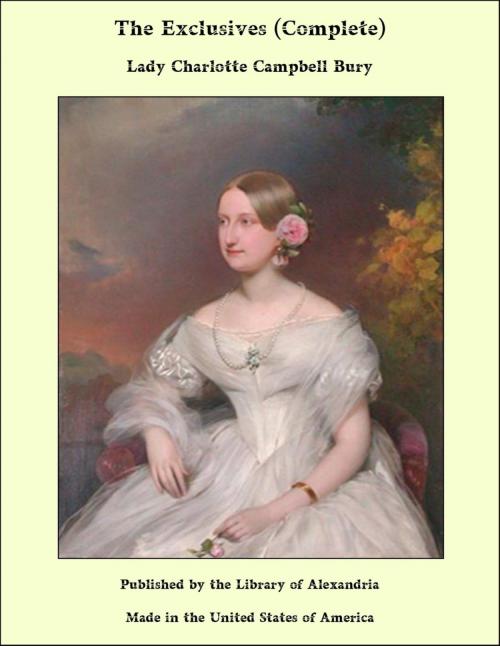The Exclusives (Complete)
Nonfiction, Religion & Spirituality, New Age, History, Fiction & Literature| Author: | Lady Charlotte Campbell Bury | ISBN: | 9781465617408 |
| Publisher: | Library of Alexandria | Publication: | March 8, 2015 |
| Imprint: | Language: | English |
| Author: | Lady Charlotte Campbell Bury |
| ISBN: | 9781465617408 |
| Publisher: | Library of Alexandria |
| Publication: | March 8, 2015 |
| Imprint: | |
| Language: | English |
The boudoir of a woman of fashion exhibits in its history, if faithfully recorded, a picture of the manners, modes, and morals of the times; and, however little such things in themselves might deserve to be handed down, or registered as objects of imitation, yet to chronicle them for the day would not be without its use. The sensible part of mankind would laugh at the follies, and wonder at the extravagance, which the page of such ephemeral history unfolded; while the actors in the scene might possibly view in the mirror held up to them their own lives, and their own actions, in a new and truer light. Lady Tilney's boudoir,—the boudoir par excellence,—was not in fact a boudoir, according to the old legitimate meaning of the word. Indeed, Lady Tilney herself, the presiding deity of the sanctuary, professed her contempt of legitimacy in boudoirs, as well as in sovereigns; at least she did so in words, though, like many other professors, her words and actions frequently contradicted each other; and it may be questioned if there are any greater despots, than those who inveigh most against despotism. But to return from this digression to the boudoir. Lady Tilney's boudoir was destined to the reception of far other votaries than those of the old rabattu god of love. No: her boudoir was visited by persons of a very different character from those who were formerly the frequenters of such a scene. Authors, poets, political intriguers, artists, and committees for the management of the state of society, formed the chief personages among those who figured there, and their business was of a very different complexion from that of the supposed use, or original meaning ascribed to a boudoir. In the former, of old, the painted harpsichord, the huge cabinet, the gigantic chimney-piece, the tapestried wall, were suited to the silken garb, and bag and sword, that formed the attire of the male part of its visitants; as well as to the hoop and fly-cap of the ladies who presided there. In this modern temple of idolatry, only a few of the ancient decorations were allowed a place, such as the marquetry cabinet, the or-moulu clock, or vase of China; but for the rest, what a change! Volumes of worth, and works of merit and deep learning, were now covered by the novels of the day, or hidden by trivial elegancies newly imported from Paris; while on the walls, the rare productions of Titian or Vandyck were intermingled with some chalky portrait of the modern school, tricked out in the millinery geer of the fashion of the day. Scattered on the tables, however, there was a redeeming feature in the character of the decorative objects which met the eye, for there lay some richly chased gold ornaments, the works of Benvenuto Cellini, or some one not less skilful, though it may be of forgotten name; and while these ornamented the apartment, they served the double purpose of affording Lady Tilney an opportunity, not only to discourse on their beauty, but to enter into all the particulars of Cellini's strange life.
The boudoir of a woman of fashion exhibits in its history, if faithfully recorded, a picture of the manners, modes, and morals of the times; and, however little such things in themselves might deserve to be handed down, or registered as objects of imitation, yet to chronicle them for the day would not be without its use. The sensible part of mankind would laugh at the follies, and wonder at the extravagance, which the page of such ephemeral history unfolded; while the actors in the scene might possibly view in the mirror held up to them their own lives, and their own actions, in a new and truer light. Lady Tilney's boudoir,—the boudoir par excellence,—was not in fact a boudoir, according to the old legitimate meaning of the word. Indeed, Lady Tilney herself, the presiding deity of the sanctuary, professed her contempt of legitimacy in boudoirs, as well as in sovereigns; at least she did so in words, though, like many other professors, her words and actions frequently contradicted each other; and it may be questioned if there are any greater despots, than those who inveigh most against despotism. But to return from this digression to the boudoir. Lady Tilney's boudoir was destined to the reception of far other votaries than those of the old rabattu god of love. No: her boudoir was visited by persons of a very different character from those who were formerly the frequenters of such a scene. Authors, poets, political intriguers, artists, and committees for the management of the state of society, formed the chief personages among those who figured there, and their business was of a very different complexion from that of the supposed use, or original meaning ascribed to a boudoir. In the former, of old, the painted harpsichord, the huge cabinet, the gigantic chimney-piece, the tapestried wall, were suited to the silken garb, and bag and sword, that formed the attire of the male part of its visitants; as well as to the hoop and fly-cap of the ladies who presided there. In this modern temple of idolatry, only a few of the ancient decorations were allowed a place, such as the marquetry cabinet, the or-moulu clock, or vase of China; but for the rest, what a change! Volumes of worth, and works of merit and deep learning, were now covered by the novels of the day, or hidden by trivial elegancies newly imported from Paris; while on the walls, the rare productions of Titian or Vandyck were intermingled with some chalky portrait of the modern school, tricked out in the millinery geer of the fashion of the day. Scattered on the tables, however, there was a redeeming feature in the character of the decorative objects which met the eye, for there lay some richly chased gold ornaments, the works of Benvenuto Cellini, or some one not less skilful, though it may be of forgotten name; and while these ornamented the apartment, they served the double purpose of affording Lady Tilney an opportunity, not only to discourse on their beauty, but to enter into all the particulars of Cellini's strange life.















